The global breast density assessment software market is valued at USD 298.3 million in 2025. It is slated to reach USD 725.8 million by 2035, recording an absolute increase of USD 427.5 million over the forecast period. This translates into a total growth of 143.3%, with the market forecast to expand at a compound annual growth rate (CAGR) of 9.3% between 2025 and 2035. The overall market size is expected to grow by nearly 2.43X during the same period, supported by increasing demand for accurate breast density measurement in mammography screening, growing adoption of AI-powered diagnostic technologies in healthcare facilities, and rising healthcare emphasis on early breast cancer detection across diverse clinical and screening applications.
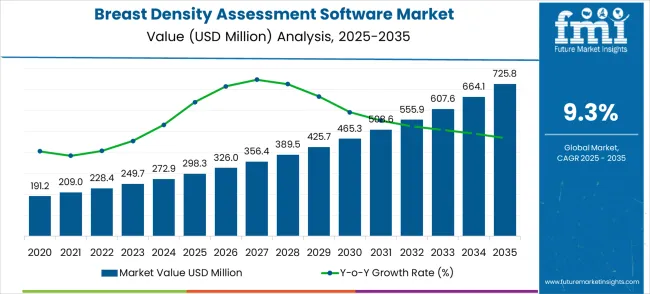
| Metric | Value |
|---|---|
| Estimated Value in (2025E) | USD 298.3 million |
| Forecast Value in (2035F) | USD 725.8 million |
| Forecast CAGR (2025 to 2035) | 9.3% |
From 2030 to 2035, the market is forecast to grow from USD 465.3 million to USD 725.8 million, adding another USD 260.5 million, which constitutes 60.9% of the overall ten-year expansion. This period is expected to be characterized by the expansion of advanced AI algorithms and machine learning technologies, the integration of cloud-based diagnostic platforms, and the development of comprehensive breast health assessment solutions incorporating multiple imaging modalities. The growing adoption of personalized medicine approaches and precision healthcare will drive demand for breast density software with enhanced risk assessment capabilities and predictive analytics features.
Between 2020 and 2025, the breast density assessment software market experienced robust growth, driven by increasing awareness about the importance of breast cancer screening and growing recognition of breast density as a critical risk factor for breast cancer development. The market developed as healthcare providers recognized the potential for automated assessment tools to enhance screening accuracy while improving workflow efficiency and diagnostic consistency. Technological advancement in artificial intelligence and imaging analysis began emphasizing the critical importance of maintaining measurement precision and clinical reliability in mammography screening programs.
Market expansion is being supported by the increasing global emphasis on early breast cancer detection and the corresponding need for accurate diagnostic tools that can provide reliable breast density measurements while enhancing screening program effectiveness across various healthcare settings and patient populations. Modern healthcare facilities are increasingly focused on implementing diagnostic solutions that can improve screening accuracy, reduce interpretation variability, and provide consistent assessment results in mammography and breast imaging applications. Breast density assessment software's proven ability to deliver standardized measurements, enhance diagnostic confidence, and support clinical decision-making makes it an essential technology for contemporary breast cancer screening and prevention programs.
The growing emphasis on personalized healthcare and risk-based screening protocols is driving demand for breast density assessment software that can support advanced risk stratification, enable tailored screening recommendations, and improve patient care through enhanced diagnostic capabilities. Healthcare providers' preference for solutions that combine diagnostic accuracy with operational efficiency and workflow optimization is creating opportunities for innovative software implementations. The rising influence of regulatory requirements for breast density notification and the increasing adoption of AI-powered diagnostic tools are also contributing to increased utilization of assessment software that can provide reliable clinical insights without compromising screening program quality or patient safety.
The breast density assessment software market presents exceptional growth opportunities driven by the intersection of AI-powered diagnostics, regulatory requirements for breast density notification, and the global emphasis on early breast cancer detection. With the market projected to expand from USD 298.3 million in 2025 to USD 725.8 million by 2035 at a robust 9.3% CAGR, healthcare technology providers are positioned to capitalize on the shift toward automated screening, personalized medicine approaches, and standardized diagnostic protocols across diverse healthcare settings.
The breast cancer screening and diagnosis segment's commanding 58% market share, combined with 2D mammography's 62% imaging modality dominance, establishes clear investment priorities for market participants. High-growth regions like China (12.6% CAGR) and India (11.6% CAGR) offer significant expansion opportunities, while developed markets provide premium positioning potential through advanced AI algorithms and comprehensive healthcare integration capabilities.
The market is segmented by imaging modality, application, and region. By imaging modality, the market is divided into 2D mammography (FFDM), 3D tomosynthesis (DBT), multimodal fusion (MRI/Ultrasound), and others. Based on application, the market is categorized into breast cancer screening and diagnosis, breast cancer prediction and prevention, and scientific research fields. Regionally, the market is divided into North America, Europe, East Asia, South Asia & Pacific, Latin America, and the Middle East & Africa.
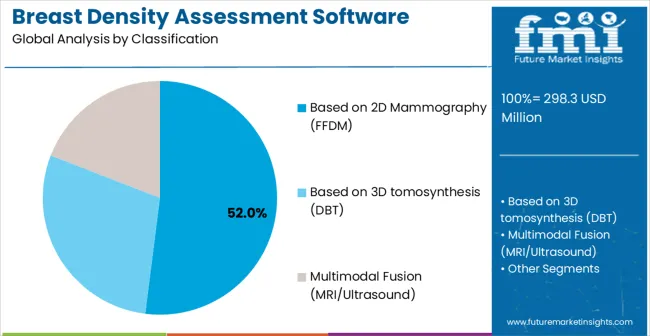
The 2D mammography (FFDM) segment is projected to account for 52% of the breast density assessment software market in 2025, reaffirming its position as the leading imaging modality category. Healthcare facilities increasingly utilize 2D mammography-based assessment software for its widespread compatibility with existing imaging infrastructure, established clinical workflows, and proven accuracy in breast density measurement across diverse patient populations and screening programs. 2D mammography technology's extensive clinical validation and universal adoption directly address the healthcare requirements for reliable breast density assessment and operational efficiency in large-scale screening operations.
This imaging modality segment forms the foundation of modern breast density assessment operations, as it represents the imaging approach with the greatest accessibility and established market penetration across multiple healthcare systems and screening facilities. Healthcare provider investments in enhanced software algorithms and automated analysis capabilities continue to strengthen adoption among mammography centers. With healthcare facilities prioritizing diagnostic accuracy and workflow efficiency, 2D mammography-based assessment software aligns with both clinical effectiveness objectives and operational integration requirements, making it the central component of comprehensive breast screening strategies.
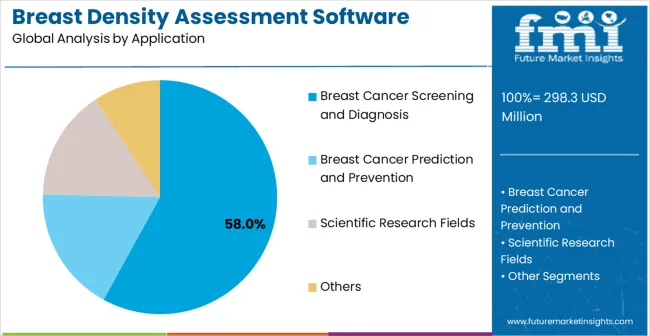
Breast cancer screening and diagnosis applications are projected to represent 58% of breast density assessment software demand in 2025, underscoring their critical role as the primary use case for automated assessment tools in clinical mammography and breast imaging applications. Healthcare providers prefer density assessment software for screening and diagnostic purposes due to its ability to enhance screening accuracy, improve diagnostic consistency, and support clinical decision-making while reducing interpretation time and workflow complexity. Positioned as essential technology for modern breast cancer screening programs, assessment software offers both diagnostic advantages and operational benefits.
The segment is supported by continuous innovation in AI-powered diagnostic technologies and the growing availability of integrated imaging solutions that enable comprehensive breast health assessment with enhanced clinical workflow capabilities. Additionally, healthcare providers are investing in automated diagnostic systems to support high-volume screening programs and consistent quality assurance. As breast cancer screening becomes more personalized and risk-based screening approaches increase, breast cancer screening and diagnosis will continue to dominate the application market while supporting advanced diagnostic technology utilization and clinical care optimization strategies.
The breast density assessment software market is advancing rapidly due to increasing awareness about breast cancer risk factors and growing demand for accurate diagnostic tools that provide reliable breast density measurements and enhanced screening program effectiveness across diverse healthcare settings and patient populations. However, the market faces challenges, including high software implementation costs, regulatory approval complexities, and the need for specialized training and clinical validation. Innovation in AI algorithms and cloud-based diagnostic platforms continues to influence product development and market expansion patterns.
The growing adoption of advanced AI algorithms and machine learning capabilities is enabling software developers to produce sophisticated breast density assessment solutions with superior accuracy, enhanced automation, and improved clinical workflow integration. AI-powered assessment systems provide better diagnostic consistency while allowing more efficient screening processes and standardized measurement protocols across various healthcare facilities. Developers are increasingly recognizing the competitive advantages of AI-driven capabilities for product differentiation and premium market positioning.
Modern breast density assessment software producers are incorporating cloud-based architectures and interoperability standards to enhance system accessibility, enable remote analysis capabilities, and ensure seamless integration with existing healthcare IT infrastructure. These technologies improve operational efficiency while enabling new capabilities, including multi-site data sharing and collaborative diagnostic workflows. Advanced cloud integration also allows developers to support scalable deployment models and enhanced functionality beyond traditional standalone software solutions.
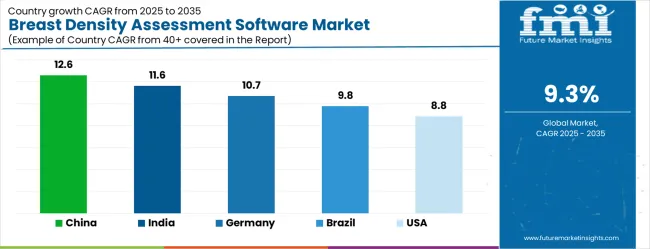
| Country | CAGR (2025-2035) |
|---|---|
| China | 12.6% |
| India | 11.6% |
| Germany | 10.7% |
| Brazil | 9.8% |
| USA | 8.8% |
| UK | 7.9% |
| Japan | 7.0% |
The breast density assessment software market is experiencing strong growth globally, with China leading at a 12.6% CAGR through 2035, driven by the rapidly expanding healthcare infrastructure, growing investment in advanced medical imaging technologies, and increasing government focus on women's health and cancer screening programs. India follows at 11.6%, supported by large-scale healthcare modernization initiatives, rising awareness about breast cancer screening, and growing adoption of digital diagnostic technologies. Germany shows growth at 10.7%, emphasizing technological innovation and premium healthcare solutions. Brazil records 9.8%, focusing on healthcare system expansion and diagnostic technology adoption. The USA demonstrates 8.8% growth, prioritizing advanced diagnostic technologies and personalized medicine approaches. The UK exhibits 7.9% growth, emphasizing healthcare digitization and screening program enhancement. Japan shows 7.0% growth, supported by advanced medical technology adoption and precision healthcare initiatives.
The report covers an in-depth analysis of 40+ countries top-performing countries are highlighted below.
Breast density assessment software in China is projected to exhibit exceptional growth with a CAGR of 12.6% through 2035, driven by rapidly expanding healthcare infrastructure and significant government investment in advanced medical imaging technologies supported by national healthcare modernization initiatives. The country's massive healthcare system development and increasing emphasis on women's health screening programs are creating substantial demand for automated diagnostic solutions. Major healthcare technology providers and medical device companies are establishing comprehensive software development capabilities to serve both domestic and international markets.
Demand for breast density assessment software in India is expanding at a CAGR of 11.6%, supported by the country's comprehensive healthcare modernization programs, rising awareness about the importance of breast cancer screening, and increasing adoption of digital diagnostic technologies in urban and rural healthcare facilities. The country's expanding healthcare infrastructure and growing focus on women's health initiatives are driving demand for advanced diagnostic software capabilities. International healthcare technology providers and domestic companies are establishing extensive development and distribution capabilities to address the growing demand for medical imaging solutions.
Breast density assessment software in Germany is expanding at a CAGR of 10.7%, supported by the country's advanced healthcare technology sector, strong emphasis on medical innovation, and robust demand for high-quality diagnostic solutions among leading healthcare institutions. The nation's mature healthcare system and commitment to precision medicine are driving sophisticated diagnostic software integration throughout medical facilities and research institutions. Leading technology companies and healthcare software developers are investing extensively in premium product development and advanced AI algorithms to serve both domestic and European markets.
Revenue from breast density assessment software in Brazil is growing at a CAGR of 9.8%, driven by expanding healthcare infrastructure, increasing investment in medical imaging technologies, and raising awareness about the importance of breast cancer screening in urban and developing regions. The country's healthcare system modernization and emphasis on preventive care are supporting demand for advanced diagnostic software across major healthcare facilities. Healthcare technology providers and medical device companies are establishing comprehensive capabilities to serve growing domestic demand and regional market opportunities.
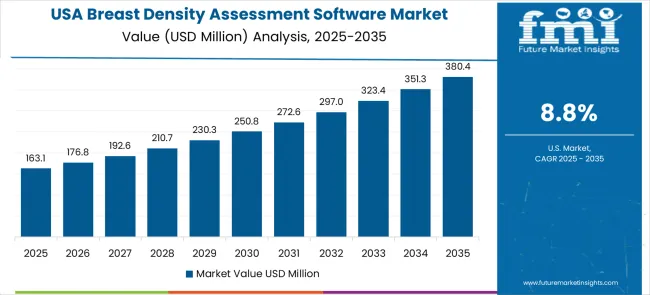
Breast density assessment software in the USA is expanding at a CAGR of 8.8%, supported by the country's advanced healthcare system, strong emphasis on personalized medicine, and established demand for innovative diagnostic technologies among leading medical institutions and healthcare networks. The USA's mature medical imaging sector and leadership in healthcare innovation are driving demand for sophisticated diagnostic software focusing on clinical accuracy and workflow optimization. Healthcare technology companies are investing in comprehensive research and development to serve domestic healthcare providers with cutting-edge diagnostic solutions.
Breast density assessment software in the UK is growing at a CAGR of 7.9%, driven by the country's comprehensive healthcare digitization initiatives, emphasis on screening program enhancement, and strong commitment to improving breast cancer detection rates through advanced diagnostic technologies. The UK's established National Health Service and focus on evidence-based healthcare are supporting investment in proven diagnostic software solutions. Healthcare technology providers are establishing comprehensive product offerings to serve both NHS requirements and private healthcare market demands.
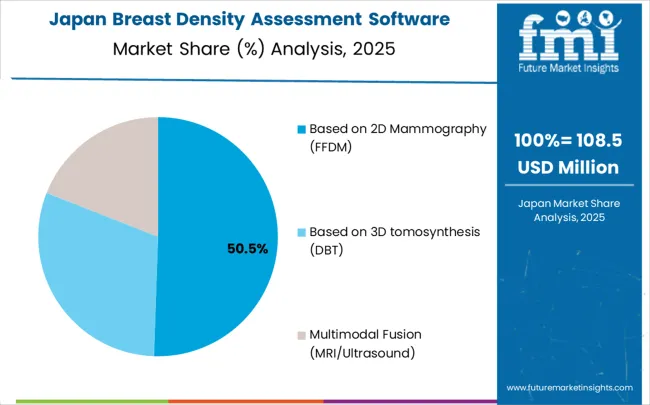
Breast density assessment software in Japan is expanding at a CAGR of 7.0%, supported by the country's focus on advanced medical technologies, precision healthcare development, and strong emphasis on early detection and preventive medicine approaches. Japan's sophisticated healthcare system and commitment to technological innovation are driving demand for advanced diagnostic software, including AI-powered assessment tools and integrated imaging solutions. Leading healthcare technology companies are investing in specialized capabilities to serve domestic medical institutions with premium diagnostic software offerings.
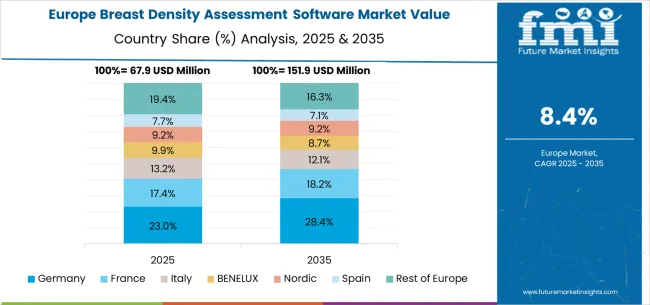
The breast density assessment software market in Europe is projected to grow from USD 65.6 million in 2025 to USD 159.6 million by 2035, registering a CAGR of 9.3% over the forecast period. Germany is expected to maintain its leadership position with a 32.0% market share in 2025, declining slightly to 31.5% by 2035, supported by its strong healthcare technology sector, advanced medical imaging facilities, and comprehensive diagnostic software supply network serving major European healthcare markets.
France follows with an 18.5% share in 2025, projected to reach 19.0% by 2035, driven by robust demand for breast screening technologies, advanced healthcare infrastructure, and comprehensive women's health programs, combined with established medical imaging traditions incorporating automated diagnostic tools. The United Kingdom holds a 16.0% share in 2025, expected to decrease to 15.5% by 2035, supported by strong NHS screening programs but facing challenges from healthcare budget constraints and competitive pressures from continental suppliers. Italy commands a 12.0% share in 2025, projected to reach 12.2% by 2035, while Spain accounts for 9.0% in 2025, expected to reach 9.3% by 2035. The Netherlands maintains a 4.0% share in 2025, growing to 4.2% by 2035. The Rest of Europe region, including Nordic countries, Eastern Europe, Portugal, Belgium, Switzerland, and Austria, is anticipated to gain momentum, expanding its collective share from 8.5% to 8.3% by 2035, attributed to increasing adoption of healthcare digitization in Nordic countries and growing medical imaging activities across Eastern European markets implementing healthcare modernization programs.
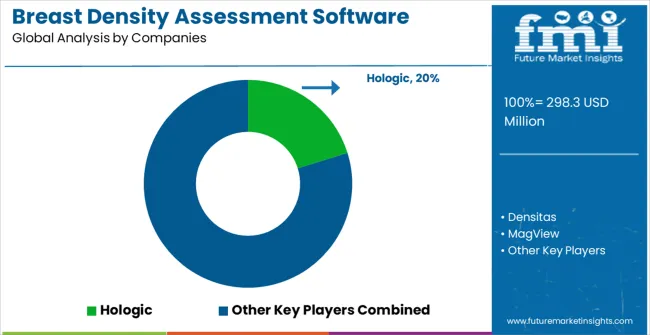
The breast density assessment software market is characterized by competition among established medical imaging companies, specialized healthcare software developers, and integrated diagnostic technology providers. Companies are investing in the development of AI algorithms, clinical validation research, regulatory compliance systems, and comprehensive product portfolios to deliver accurate, reliable, and clinically validated diagnostic solutions. Innovation in machine learning technologies, cloud-based platforms, and integrated imaging workflows is central to strengthening market position and competitive advantage.
Hologic leads the market with a strong market share, offering comprehensive breast imaging solutions with a focus on mammography systems and integrated diagnostic software. Densitas provides specialized breast density assessment technologies with an emphasis on AI-powered analysis and clinical accuracy. MagView delivers innovative imaging software with a focus on automated assessment and workflow optimization. Volpara Health specializes in breast imaging analytics and risk assessment solutions for healthcare providers. iCAD, Inc. focuses on AI-powered diagnostic solutions and computer-aided detection technologies. Siemens Healthineers offers integrated medical imaging systems with comprehensive diagnostic software capabilities.
| Items | Values |
|---|---|
| Quantitative Units (2025) | USD 298.3 million |
| Imaging Modality | Based on 2D Mammography (FFDM), Based on 3D tomosynthesis (DBT), Multimodal Fusion (MRI/Ultrasound), Others |
| Application | Breast Cancer Screening and Diagnosis, Breast Cancer Prediction and Prevention, Scientific Research Fields |
| Regions Covered | North America, Europe, East Asia, South Asia & Pacific, Latin America, Middle East & Africa |
| Countries Covered | United States, Canada, United Kingdom, Germany, France, China, Japan, South Korea, India, Brazil, Australia and 40+ countries |
| Key Companies Profiled | Hologic, Densitas, MagView, Volpara Health, iCAD, Inc., and Siemens Healthineers |
| Additional Attributes | Dollar sales by imaging modality and application category, regional demand trends, competitive landscape, technological advancements in AI algorithms, cloud-based platform integration, clinical validation processes, and supply chain optimization |
The global breast density assessment software market is estimated to be valued at USD 298.3 million in 2025.
The market size for the breast density assessment software market is projected to reach USD 725.8 million by 2035.
The breast density assessment software market is expected to grow at a 9.3% CAGR between 2025 and 2035.
The key product types in breast density assessment software market are based on 2d mammography (ffdm), based on 3d tomosynthesis (dbt) and multimodal fusion (mri/ultrasound).
In terms of application, breast cancer screening and diagnosis segment to command 58.0% share in the breast density assessment software market in 2025.






Our Research Products

The "Full Research Suite" delivers actionable market intel, deep dives on markets or technologies, so clients act faster, cut risk, and unlock growth.

The Leaderboard benchmarks and ranks top vendors, classifying them as Established Leaders, Leading Challengers, or Disruptors & Challengers.

Locates where complements amplify value and substitutes erode it, forecasting net impact by horizon

We deliver granular, decision-grade intel: market sizing, 5-year forecasts, pricing, adoption, usage, revenue, and operational KPIs—plus competitor tracking, regulation, and value chains—across 60 countries broadly.

Spot the shifts before they hit your P&L. We track inflection points, adoption curves, pricing moves, and ecosystem plays to show where demand is heading, why it is changing, and what to do next across high-growth markets and disruptive tech

Real-time reads of user behavior. We track shifting priorities, perceptions of today’s and next-gen services, and provider experience, then pace how fast tech moves from trial to adoption, blending buyer, consumer, and channel inputs with social signals (#WhySwitch, #UX).

Partner with our analyst team to build a custom report designed around your business priorities. From analysing market trends to assessing competitors or crafting bespoke datasets, we tailor insights to your needs.
Supplier Intelligence
Discovery & Profiling
Capacity & Footprint
Performance & Risk
Compliance & Governance
Commercial Readiness
Who Supplies Whom
Scorecards & Shortlists
Playbooks & Docs
Category Intelligence
Definition & Scope
Demand & Use Cases
Cost Drivers
Market Structure
Supply Chain Map
Trade & Policy
Operating Norms
Deliverables
Buyer Intelligence
Account Basics
Spend & Scope
Procurement Model
Vendor Requirements
Terms & Policies
Entry Strategy
Pain Points & Triggers
Outputs
Pricing Analysis
Benchmarks
Trends
Should-Cost
Indexation
Landed Cost
Commercial Terms
Deliverables
Brand Analysis
Positioning & Value Prop
Share & Presence
Customer Evidence
Go-to-Market
Digital & Reputation
Compliance & Trust
KPIs & Gaps
Outputs
Full Research Suite comprises of:
Market outlook & trends analysis
Interviews & case studies
Strategic recommendations
Vendor profiles & capabilities analysis
5-year forecasts
8 regions and 60+ country-level data splits
Market segment data splits
12 months of continuous data updates
DELIVERED AS:
PDF EXCEL ONLINE
Construction Risk Assessment Software Market Size and Share Forecast Outlook 2025 to 2035
Software-Defined Wide Area Network Market Size and Share Forecast Outlook 2025 to 2035
Breast Reconstruction Meshes Market Size and Share Forecast Outlook 2025 to 2035
Breast MRI Screening Market Size and Share Forecast Outlook 2025 to 2035
Density Tester Market Size and Share Forecast Outlook 2025 to 2035
Software Defined Vehicle Market Size and Share Forecast Outlook 2025 to 2035
Software Defined Networking (SDN) And Network Function Virtualization (NFV) Market Size and Share Forecast Outlook 2025 to 2035
Software Defined Perimeter (SDP) Market Size and Share Forecast Outlook 2025 to 2035
Breast Cancer Grading Tools Market Size and Share Forecast Outlook 2025 to 2035
Breast Cancer Screening Tests Market Size and Share Forecast Outlook 2025 to 2035
Breast Cancer Diagnostics Market Size and Share Forecast Outlook 2025 to 2035
Software-Defined Wide Area Network SD-WAN Market Size and Share Forecast Outlook 2025 to 2035
Breast Biopsy Market Size and Share Forecast Outlook 2025 to 2035
Breast Lesion Localization Device Market Analysis - Size, Share, and Forecast Outlook 2025 to 2035
Software Defined Radio (SDR) Market Size and Share Forecast Outlook 2025 to 2035
Software License Management (SLM) Market Size and Share Forecast Outlook 2025 to 2035
Breast Lesion Localization Market Size and Share Forecast Outlook 2025 to 2035
Breastfeeding Accessories Market Size and Share Forecast Outlook 2025 to 2035
Software-Defined Networking SDN Market Size and Share Forecast Outlook 2025 to 2035
Software-Defined Anything (SDx) Market Size and Share Forecast Outlook 2025 to 2035

Thank you!
You will receive an email from our Business Development Manager. Please be sure to check your SPAM/JUNK folder too.
Chat With
MaRIA